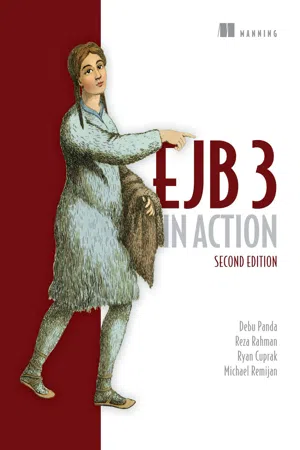
- 560 pages
- English
- ePUB (mobile friendly)
- Available on iOS & Android
EJB 3 in Action
About this book
Summary Building on the bestselling first edition, EJB 3 in Action, Second Edition tackles EJB 3.2 head-on, through numerous code samples, real-life scenarios, and illustrations. This book is a fast-paced tutorial for Java EE 6 business component development using EJB 3.2, JPA 2, and CDI. Besides covering the basics of EJB 3.2, this book includes in-depth EJB 3.2 internal implementation details, best practices, design patterns, and performance tuning tips.Purchase of the print book includes a free eBook in PDF, Kindle, and ePub formats from Manning Publications. About the Book The EJB 3 framework provides a standard way to capture business logic in manageable server-side modules, making it easier to write, maintain, and extend Java EE applications. EJB 3.2 provides more enhancements and intelligent defaults and integrates more fully with other Java technologies, such as CDI, to make development even easier. EJB 3 in Action, Second Edition is a fast-paced tutorial for Java EE business component developers using EJB 3.2, JPA, and CDI. It tackles EJB head-on through numerous code samples, real-life scenarios, and illustrations. Beyond the basics, this book includes internal implementation details, best practices, design patterns, performance tuning tips, and various means of access including Web Services, REST Services, and WebSockets.Readers need to know Java. No prior experience with EJB or Java EE is assumed. What's Inside
- Fully revised for EJB 3.2
- POJO persistence with JPA 2.1
- Dependency injection and bean management with CDI 1.1
- Interactive application with WebSocket 1.0
About the Authors Debu Panda, Reza Rahman, Ryan Cuprak, and Michael Remijan are seasoned Java architects, developers, authors, and community leaders. Debu and Reza coauthored the first edition of EJB 3 in Action. Table of Contents
PART 1 OVERVIEW OF THE EJB LANDSCAPE
- What's what in EJB 3
- A first taste of EJB
- PART 2 WORKING WITH EJB COMPONENTS
- Building business logic with session beans
- Messaging and developing MDBs
- EJB runtime context, dependency injection, and crosscutting logic
- Transactions and security
- Scheduling and timers
- Exposing EJBs as web services
- PART 3 USING EJB WITH JPA AND CDI
- JPA entities
- Managing entities
- JPQL
- Using CDI with EJB 3
- PART 4 PUTTING EJB INTO ACTION
- Packaging EJB 3 applications
- Using WebSockets with EJB 3
- Testing and EJB
Frequently asked questions
- Essential is ideal for learners and professionals who enjoy exploring a wide range of subjects. Access the Essential Library with 800,000+ trusted titles and best-sellers across business, personal growth, and the humanities. Includes unlimited reading time and Standard Read Aloud voice.
- Complete: Perfect for advanced learners and researchers needing full, unrestricted access. Unlock 1.4M+ books across hundreds of subjects, including academic and specialized titles. The Complete Plan also includes advanced features like Premium Read Aloud and Research Assistant.
Please note we cannot support devices running on iOS 13 and Android 7 or earlier. Learn more about using the app.
Information
Part 1. Overview of the EJB landscape
Chapter 1. What’s what in EJB 3
- The EJB container and its role in Enterprise applications
- The different types of Enterprise Java Beans (EJBs)
- Closely related technologies such as the Java Persistence API (JPA)
- The different EJB runtime environments
- Innovations started with EJB 3
- New changes with EJB 3.2
1.1. EJB overview
1.1.1. EJB as a component model
1.1.2. EJB component services
Table of contents
- Copyright
- Brief Table of Contents
- Table of Contents
- Praise for the First Edition
- Preface
- Acknowledgments
- About this Book
- About the Authors
- About the Cover Illustration
- Part 1. Overview of the EJB landscape
- Part 2. Working with EJB components
- Part 3. Using EJB with JPA and CDI
- Part 4. Putting EJB into action
- Appendix A. Deployment descriptor reference
- Appendix B. Getting started with Java EE 7 SDK
- Appendix C. EJB 3 developer certification exam
- Index
- List of Figures
- List of Tables
- List of Listings